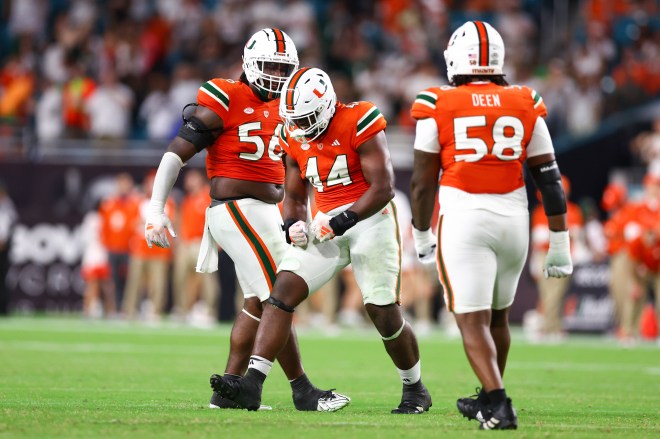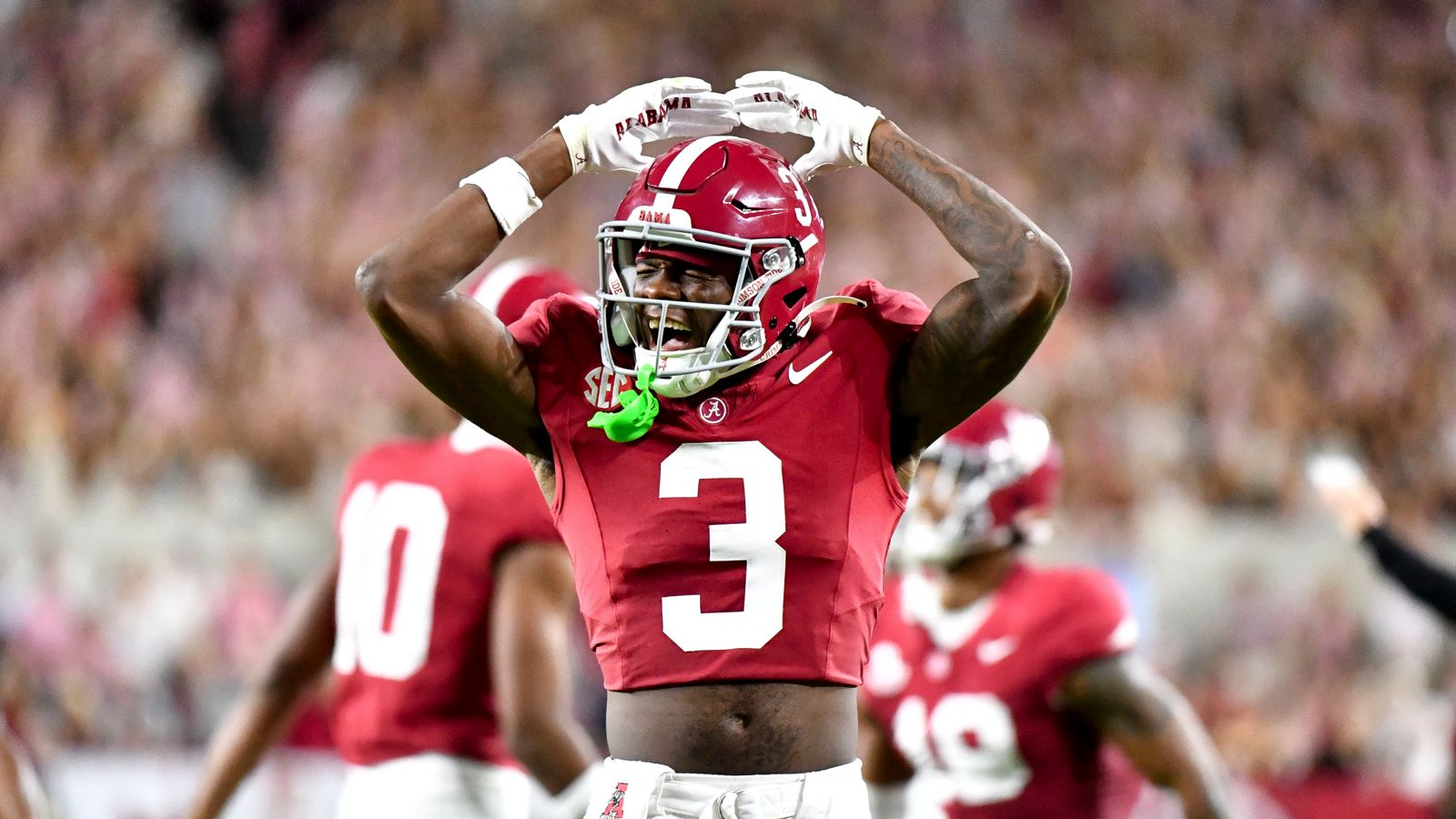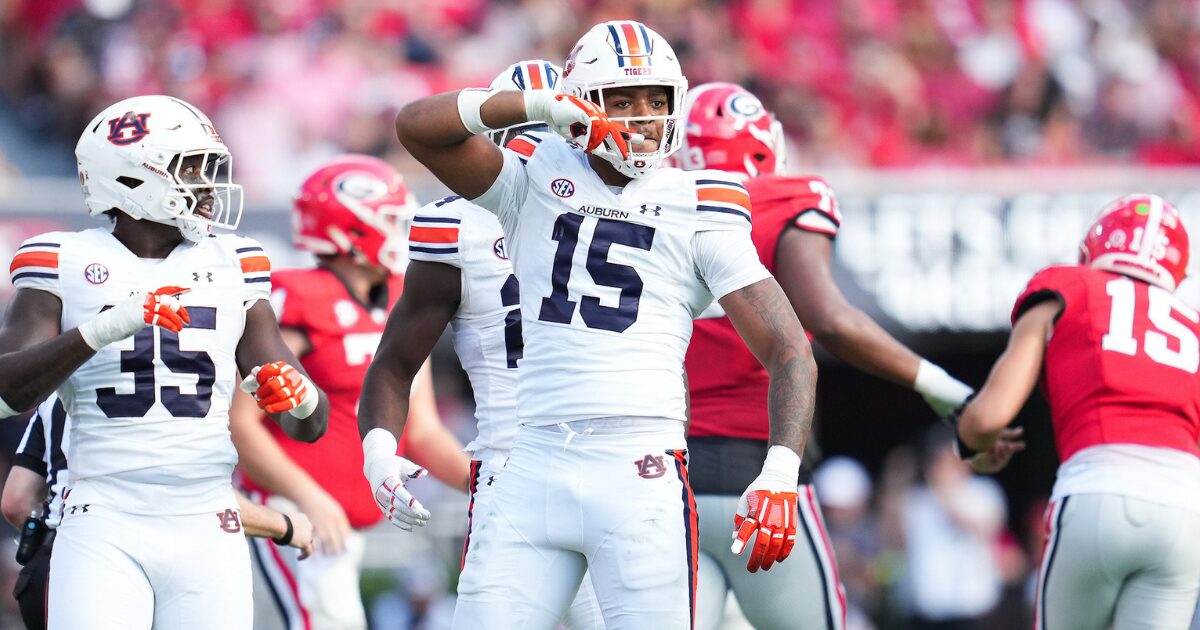By Charlie Campbell.
Send Charlie an e-mail here: [email protected]
Follow Charlie on Twitter @draftcampbell for updates.
This page was last updated March 5, 2021. Follow me @walterfootball for updates.
Position Review: Wide Receivers
Wide Receiver Class
Early-round talent: A-
Mid-round: A
Late-round: B
Overall grade: A-
2021 prospects vs 2020
Ja’Marr Chase
Jerry Jeudy
CeeDee Lamb
DeVonta Smith
Henry Ruggs
Justin Jefferson
Jaylen Waddle
Jalen Reagor
Brandon Aiyuk
Tee Higgins
Terrace Marshall
Kadarius Toney
Michael Pittman Jr.
Rondale Moore
Sage Surratt
Rashod Bateman
Just to be clear this article and series is all my opinion based off my own study and information I’ve gotten from general managers, directors of college scouting, national scouts, area scouts, and NFL coaches who know way more than I do.
Last year’s class of wide receivers was phenomenal. There was excellent talent in the first round of the 2020 NFL Draft, and there were wideouts who went in the second and third round who would have gone a round higher in a typical year. There were some superb value picks on the second day of the 2020 NFL Draft and into the early rounds of Day 3. It was a rare A+ class, so it is not surprising that this year is not as good. The 2021 NFL Draft, however, is also very strong at wide receiver, containing a lot of good talent for Day 2 and the mid-rounds of the 2021 NFL Draft.
If you were to merge the two classes together, Chase would be the top prospect overall. Things become more debatable after him, with some teams having DeVonta Smith graded lower than others due to size concerns. I personally like Smith more than Henry Ruggs, and I felt that CeeDee Lamb and Jerry Jeudy should have gone over Ruggs. I think Jaylen Waddle is not as good of a prospect as Justin Jefferson, but better than Jalen Reagor and Brandon Aiyuk.
I rate Terrace Marshall and Kadarius Toney as high second-round prospects similar to Tee Higgins and Michael Pittman Jr. I think Sage Surratt and Rashod Bateman belong late in Round 2 to early in Round 3. In the same second-day mix are some really good receiver prospects like Houston’s Marquez Stevenson, Purdue’s Rondale Moore, Oklahoma State’s Tylan Wallace and Florida State’s Tamorrion Terry. Some of them could go ahead of Surratt and Bateman, as beauty is in the eye of the beholder.
Safest Pick: Ja’Marr Chase, LSU

Previous Picks:
2020: Jerry Jeudy
2019: Deebo Samuel
2018: Christian Kirk
2017: Corey Davis
2016: Will Fuller
2015: Amari Cooper
2014: Sammy Watkins
2013: DeAndre Hopkins
My track record here is pretty good. Hopkins has turned into one of the best players in the NFL regardless of position and is a phenomenal playmaker. Watkins has played well when healthy. Cooper has been inconsistent, but still is a good pro. Fuller has been excellent when healthy and is underrated across the league. Davis was injured for a lot of his rookie year but came alive in 2020. Kirk had a solid start to his career, while Samuel was sensational as a rookie and banged up in his second year. Jeudy flashed as a rookie and could be a good pro if he gets help from his quarterback.
This was not an easy choice, but I think Chase translates the best to the NFL because he has a bigger frame than DeVonta Smith or Jaylen Waddle. Chase has game-breaking speed, excellent route-running, solid hands, quality size, and natural receiving ability. I think he could be a better version of Amari Cooper in the NFL.
Biggest Bust Potential: Elijah Moore, Ole Miss

Previous Picks:
2020: Denzel Mims
2019: N’Keal Harry
2018: Auden Tate
2017: Curtis Samuel
2016: Corey Coleman
2015: Devin Funchess
2014: Kelvin Benjamin
2013: Cordarrelle Patterson
My track record here is pretty good. Obviously, a few more seasons are needed to render any judgment on Mims. Harry has been a disappointment thus far, but has time to turn it around. Tate was a seventh-round pick, so if he doesn’t pan out, he would not be a true bust given where he was taken. Samuel is a solid pro, so that bust was averted.
Other than Samuel, the rest of the group looks like a collection of busts. In 2016, I almost went with Laquon Treadwell, but chose Coleman. Both of them were huge busts. Funchess had one decent season for Carolina, but overall, he was a disappointment as a second-round pick. Benjamin had a roller coaster career, and he ended up being a bust for Carolina and Buffalo. Patterson was a bust for Minnesota.
This was a difficult decision because none of the early-round receivers look like a danger for serious bust potential. I ended up going with Moore because some in the media have projected him going in the first round, but I know some teams that have him graded as a mid-rounder and future backup. Moore (5-9, 184) is undersized and really only fits as a slot receiver. Given those limitations, I could see him being a disappointment if he is taken in the early rounds of the 2021 NFL Draft.
Wide Receiver Rankings by Attributes
Separation:
NFL prototype: Antonio Brown, Buccaneers
- DeVonta Smith
- Ja’Marr Chase
- Jaylen Waddle
- Kadarius Toney
- Rondale Moore
- Terrace Marshall Jr.
- Rashod Bateman
- Sage Surratt
Recap: A few pro wide receivers coaches shared that the ability to separate from coverage is the first trait they look for in scouting draft prospects. Smith is the best in this draft class at creating space from defensive backs. He does it with good speed, quick feet, fast route-running, and suddenness out of his breaks. Smith’s separation skills are one of his strongest traits.
Chase and Waddle are ultra-fast receivers who can separate from defensive backs based on pure foot speed. They are tough for defensive backs to run with and are able to generate space running vertically or crossing the field. Both are dynamic playmaker, but Chase’s route-running is ahead of Waddle’s, so he gets the edge and is rated higher.
Both Toney and Moore are threats to blow by defensive backs on any snap. They are explosive wideouts who can run past defensive backs and are sudden out of breaks. Toney’s separation skills in 2020 were phenomenal, allowing him to have his way with the SEC defensive backs. Both Moore and Toney are going to be a tough coverage assignment for NFL cornerbacks.
Marshall can get separation using his speed running vertical routes downfield. While he is not instantly explosive or sudden, Marshall has build-up speed and takes defensive backs by surprise.
Bateman could have issues generating consistent separation from NFL cornerbacks. To go along with not being very fast, Bateman is not a twitchy or explosive athlete, so he could have separation issues against pro cornerbacks.
Surratt will probably struggle to generate separation from NFL cornerbacks. However, he is a size mismatch who presents the danger of winning a lot of contested catches over defensive backs. Thus, Surratt does not have to be wide open to make big plays.
Hands:
NFL prototype: DeAndre Hopkins, Cardinals
- DeVonta Smith
- Sage Surratt
- Ja’Marr Chase
- Rondale Moore
- Jaylen Waddle
- Rashod Bateman
- Kadarius Toney
- Terrace Marshall Jr.
Recap: This year has a nice crop of sure-handed receivers. Smith has phenomenal hands, and you never saw him drop a pass. Back before the 2020 NFL Draft, scouts said Smith had, by far, the best hands of the Alabama foursome of Jerry Jeudy, Henry Ruggs, Jaylen Waddle, and Smith. Smith attacks the football with his hand and really snatches it out of the air. Making catches looks easy and effortless for Smith, who is a natural hands receiver.
Surratt possesses very good hands. He has the strength to snatch the ball and rip it out of the air. Chase shows steady, reliable hands. Moore, Waddle, Bateman and Toney don’t have bad hands, but they drop some passes. Their drop rates were not anything alarming, but they all have room for improvement in the NFL. Marshall does not have a critical problem with his hands, but he had some drops. On the flip side, he also made some amazing one-handed highlight-reel catches. He just needs to become a little more consistent on the routine plays.
Deep Speed:
NFL prototype: Tyreek Hill, Chiefs
- Jaylen Waddle
- Ja’Marr Chase
- DeVonta Smith
- Rondale Moore
- Kadarius Toney
- Terrace Marshall Jr.
- Rashod Bateman
- Sage Surratt
Recap: There a number of receivers in this group who have the ability to stretch the field vertically. Waddle and Chase are legit deep-threat receivers with dangerous speed going deep. They are very fast players can take a top off of a defense. The deep speed each has is a special dimension they bring to the table.
Smith, Moore and Toney are dangerous deep-threat receivers for the NFL, and they all showed that over the course of their college careers. They all have explosive speed with first-step quickness and a second gear to accelerate away from defensive backs. These three can take the top off a defense and score on any reception.
Marshall is dangerous running at verticals because he has build-up speed and is fast running straight down the field. He is a threat to burn coverage over the top and score long touchdowns. Defenses have to account for him in the deep part of the field.
Bateman is a not a deep-speed receiver who burns defenses with pure explosion, but he does make some plays downfield. He has quickness and is adept at making difficult catches downfield with defenders close by him.
Surratt is not a burner for the NFL, but he has enough quickness to get downfield and then use his mismatch size along the sideline. That combination makes him a threat to produce some big plays downfield via catches over defensive backs.
Route-Running:
NFL prototype: Stefon Diggs, Bills
- DeVonta Smith
- Ja’Marr Chase
- Kadarius Toney
- Rondale Moore
- Rashod Bateman
- Sage Surratt
- Jaylen Waddle
- Terrace Marshall Jr.
Recap: Route-running is a critical part of gaining separation in the NFL. Wide receivers who get sloppy in their routes have a hard time getting open. Extra steps allow defensive backs to maintain coverage or more time to recover. All eight wideouts in this group are quality route-runners.
Smith is an amazing route-runner and one of the best route-runners entering the NFL over the last decade. He is sudden in and out of his breaks with quickness and never takes extra steps, so his route-running often produces immediate separation from cornerbacks. When route-running is taught to young wide receivers at the college level, tape of Smith’s route-running at Alabama could serve as the prototype.
Chase is a very polished receiver who possesses advanced route-running. With his precise feet, ability to avoid wasted steps, and explosion out of breaks, he consistently generates separation.
Toney and Moore are plus route-runners. Toney is a smooth route-runner who is good at running the slants, crosses, outs and dig routes. Moore’s speed allows him to quickly get open in the short to intermediate part of the field. He does a nice job of running downfield routes and is sudden out of his breaks.
Bateman shows quality technique as a route-runner and has been coached well. He doesn’t take false steps and runs crisp routes. Bateman is quick enough, and his size allows him to present a good target on short to intermediate routes.
Surratt is a quality route-runner, but for the NFL, he could use some development in running a wider variety. Waddle showed route-running issues in 2019, but he looked significantly improved in 2020. He still has room for development as a route-runner, but in time, he could be good at it. Many receivers with his skill set have had route-running issues in part from how they were utilized in college as gadget players.
Marshall needs to improve his route running, and he did not run the entire route tree at LSU. Thus, Marshall will need to work on his route-running and improve his technique as a route-runner to make up for his lack of twitch and suddenness coming out of breaks.
Yards After the Catch:
NFL prototype: Julio Jones, Falcons
- Ja’Marr Chase
- Kadarius Toney
- DeVonta Smith
- Jaylen Waddle
- Rondale Moore
- Rashod Bateman
- Sage Surratt
- Terrace Marshall Jr.
Recap: The ability to turn a short reception into a big gain can make a wide receiver elite. Among the eight receivers above, all of them have some run-after-the-catch ability, and I wouldn’t say any of them is really bad.
That being said, the first five are pretty special. Chase is very dangerous with the ball in his hands. Being fast and sudden translates to Chase being a dangerous weapon to pick up yards after the catch. He is elusive in the open field with good moves to dodge tacklers and vision to see openings for longer gains.
What really sets Toney apart is how dangerous he is with the ball in his hands. He has excellent vision to weave around defenders and uses his speed to rip off yards in chunks. Along with a quick first-step, Toney has a second gear and a burst in the open field with some serious explosion. He possesses quick feet with cutting ability to stop-start, stutter step, contact balance, and run tough to get yards after contact. When the ball hits Toney on the run, he is a big problem for defenders because he is tough to grab in the open field thanks to his shifty moves. Toney has enough speed to run away from defenders and take a catch the distance. He is superb on screens and jet sweeps to race through the defense.
Smith is superb after the catch, possessing moves in the open field and a second gear to run away from defenders. He cuts and jukes around them, and his suddenness makes him tough to get a hold of. With one move or two, Smith always gets vertical and explodes down the field.
Waddle and Moore can be deadly when they get the ball in their hands. They both have tremendous yards-after-the-catch ability with elite speed and elusive moves in the open field.
After the catch, Bateman is a good runner and is able to add yardage while showing some strength to break tackles. Surrat is a tough runner after the catch, possessing the size to fight through tackles and having quality vision and cutting ability for a big receiver. Marshall is a tough runner who will use his size to break tackles, and he has a nose for the end zone with the deep speed to run away from defensive backs.
Red Zone:
NFL prototype: Davante Adams, Packers
- Ja’Marr Chase
- DeVonta Smith
- Sage Surratt
- Terrace Marshall Jr.
- Rashod Bateman
- Kadarius Toney
- Jaylen Waddle
- Rondale Moore
Recap: This was a tough category to rank because so many of the receivers were excellent point producers in college. Chase is phenomenal in the red zone, producing 20 touchdowns over the past two seasons. He is dangerous red-zone threat given his speed to get open, quality size, leaping ability, and ability to win 50-50 passes. As a sophomore, Chase was a point machine for LSU and he dominated in the end zone. That is one of his great traits for the NFL.
Smith notched a ridiculous 23 touchdowns in 2020. He uses his dynamic speed and route-running to get open, but he also plays the ball so well with quality height to make contested catches.
Surratt is a dangerous fade route target who can make catches over defenders. He is a red-zone mismatch problem for defenses.
Marshall has a nose for the end zone, and he uses his large frame to run through tackles. He was a dynamic red-zone weapon – totaling 23 touchdowns across the past two seasons – despite fewer opportunities as the third receiver in 2019 and having the 2020 season restricted with fewer games and changing quarterbacks.
Bateman’s route-running, yards-after-the-catch skills, and ability to pick up ground after contact make him dangerous to score from yards out.
Toney is a red-zone problem given his explosive speed to get open, and he has the flexibility to contribute as a running back or wild-cat back in goal-line situations. At Florida, Toney showed the ability to contribute as a runner and receiver. That versatility will help his NFL offense to produce points in the red zone.
Waddle and Moore found the end zone well for their college teams. They are threats to score on any reception, but in the condensed field, they are restricted vertically. Each can still contribute, however, by using their speed to uncover and get open quickly. Similar to Toney, Waddle and Moore also can do some gadget runs. Both could be solid red-zone contributors in the NFL.
NFL Picks - Dec. 31
2026 NFL Mock Draft - Dec. 31
NFL Power Rankings - Dec. 29
Fantasy Football Rankings - Sept. 1




